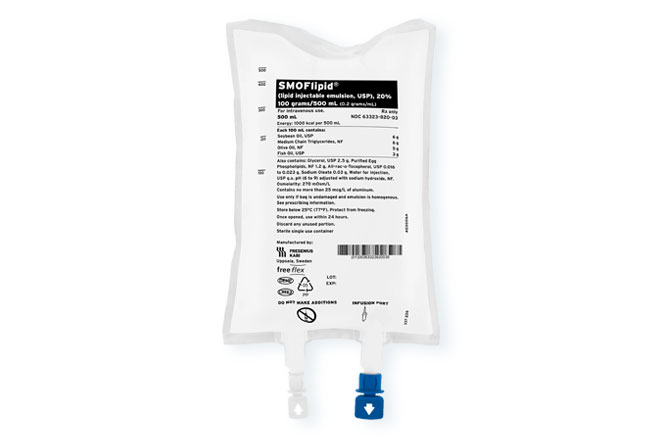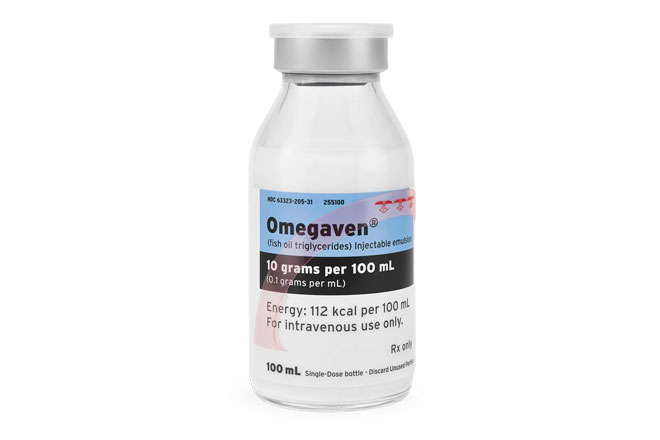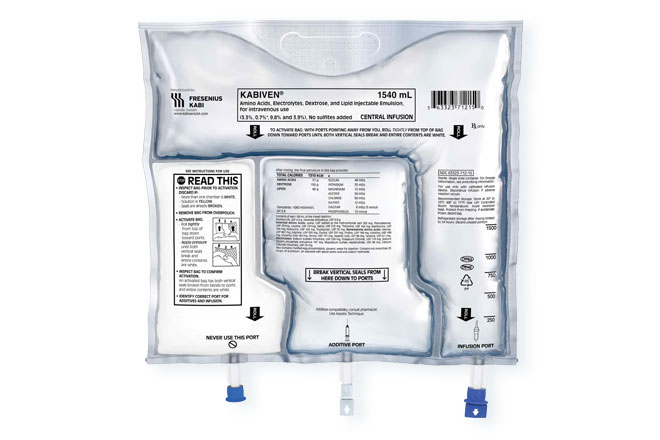INDICATIONS AND USAGE
SMOFlipid is indicated in adult and pediatric patients, including term and preterm neonates, as a source of calories and essential fatty acids for parenteral nutrition (PN) when oral or enteral nutrition is not possible, insufficient, or contraindicated.
IMPORTANT SAFETY INFORMATION & INDICATIONS
For intravenous infusion only into a central or peripheral vein. Use a non-vented non-DEHP 1.2 micron in-line filter set during administration. Recommended dosage depends on age, energy expenditure, clinical status, body weight, tolerance, ability to metabolize and eliminate lipids, and consideration of additional energy given to the patient.
The recommended dose for adults and pediatrics is shown in Table 1. For information on age-appropriate infusion rate, see the full prescribing information. SMOFlipid Pharmacy Bulk Package is only indicated for use in pharmacy admixture programs for the preparation of three-in-one or total nutrition admixtures. Protect the admixed PN solution from light.
Table 1: Recommended Adult and Pediatric Dosage
| Age |
Nutritional Requirements |
| Initial Recommended Dosage |
Maximum Dosage |
| Birth to 2 years of age (including preterm and term neonates) |
0.5 to 1 g/kg/day |
3 g/kg/day |
| Pediatric patients 2 to <12 years of age |
1 to 2 g/kg/day |
3 g/kg/day |
| Pediatric patients 12 to 17 years of age |
1 g/kg/day |
2.5 g/kg/day |
| Adults |
1 to 2 g/kg/day |
2.5 g/kg/day |
SMOFlipid is contraindicated in patients with known hypersensitivity to fish, egg, soybean, peanut, or any of the active or inactive ingredients, and severe disorders of lipid metabolism characterized by hypertriglyceridemia (serum triglycerides >1,000 mg/dL).
Clinical Decompensation with Rapid Infusion of Intravenous Lipid Emulsion in Neonates and Infants: Acute respiratory distress, metabolic acidosis, and death after rapid infusion of intravenous lipid emulsions have been reported.
Parenteral Nutrition-Associated Liver Disease: Increased risk in patients who received parenteral nutrition for greater than 2 weeks, especially preterm neonates. Monitor liver tests; if abnormalities occur consider discontinuation or dosage reduction.
Hypersensitivity Reactions: Monitor for signs or symptoms. Discontinue infusion if reactions occur.
Risk of Infections, Fat Overload Syndrome, Refeeding Syndrome, Hypertriglyceridemia, and Essential Fatty Acid Deficiency: Monitor for signs and symptoms; monitor laboratory parameters.
Aluminum Toxicity: Increased risk in patients with renal impairment, including preterm neonates.
Most common adverse drug reactions (≥5%) from clinical trials in adults were nausea, vomiting, and hyperglycemia. Most common adverse drug reactions (≥5%) from clinical trials in pediatric patients were anemia, vomiting, increased gamma-glutamyltransferase, and nosocomial infection.
To report SUSPECTED ADVERSE REACTIONS, contact Fresenius Kabi USA, LLC at 1-800-551-7176, option 5, or FDA at 1-800-FDA-1088 or www.fda.gov/medwatch (Opens in a New Window).
This Important Safety Information does not include all the information needed to use SMOFlipid safely and effectively. Please see full prescribing information, for intravenous use at https://freseniuskabinutrition.com/SMOFlipidPI (Opens in a New Window)
INDICATIONS AND USAGE
Omegaven is indicated as a source of calories and fatty acids in pediatric patients with parenteral nutrition-associated cholestasis (PNAC).
Limitations of Use:
Omegaven is not indicated for the prevention of PNAC. It has not been demonstrated that Omegaven prevents PNAC in parenteral nutrition (PN)-dependent patients.
IMPORTANT SAFETY INFORMATION & INDICATIONS
Protect the admixed PN solution from light. Prior to administration, correct severe fluid and electrolyte disorders and measure serum triglycerides to establish a baseline level. Initiate dosing in PN-dependent pediatric patients as soon as direct or conjugated bilirubin levels are 2 mg/dL or greater. The recommended nutritional requirements of fat and recommended dosages of Omegaven to meet those requirements for pediatric patients are provided in Table 1, along with recommendations for the initial and maximum infusion rates. Administer Omegaven until direct or conjugated bilirubin levels are less than 2 mg/dL or until the patient no longer requires PN.
It has not been demonstrated that the clinical outcomes observed in patients treated with Omegaven are a result of the omega-6: omega-3 fatty acid ratio of the product.
Table 1: Recommended Pediatric Dosage and Infusion Rate
| Nutritional Requirements |
Direct Infusion Rate |
| Recommended Initial Dosage and Maximum Dosage |
Initial |
Maximum |
| 1 g/kg/day; this is also the maximum daily dose |
0.2 mL/kg/hour for the first 15 to 30 minutes; gradually increase to the required rate after 30 minutes |
1.5 mL/kg/hour |
Omegaven is contraindicated in patients with known hypersensitivity to fish or egg protein or to any of the active ingredients or excipients, severe hemorrhagic disorders due to a potential effect on platelet aggregation, severe hyperlipidemia or severe disorders of lipid metabolism characterized by hypertriglyceridemia (serum triglyceride concentrations greater than 1,000 mg/dL).
Clinical Decompensation with Rapid Infusion of Lipid Injectable Emulsions in Neonates and Infants: Acute respiratory distress, metabolic acidosis, and death after rapid infusion of intravenous lipid emulsions have been reported. Hypertriglyceridemia was commonly reported. Strictly adhere to the recommended total daily dosage; the hourly infusion rate should not exceed 1.5 mL/kg/hour. Carefully monitor the infant’s ability to eliminate the infused lipids from the circulation (e.g., measure serum triglycerides and/or plasma free fatty acid levels). If signs of poor clearance of lipids from the circulation occur, stop the infusion and initiate a medical evaluation.
Hypersensitivity Reactions: Monitor for signs or symptoms. Discontinue infusion if reaction occurs.
Infections, Fat Overload Syndrome, Refeeding Syndrome, and Hypertriglyceridemia: Monitor for signs and symptoms; monitor laboratory parameters.
Aluminum Toxicity: Increased risk in patients with renal impairment, including preterm infants.
Monitoring and Laboratory Tests: Routine laboratory monitoring is recommended, including monitoring for essential fatty acid deficiency.
The most common adverse drug reactions (>15%) are: vomiting, agitation, bradycardia, apnea and viral infection.
To report SUSPECTED ADVERSE REACTIONS, contact Fresenius Kabi USA, LLC at 1-800-551-7176, option 5, or FDA at 1-800-FDA-1088 or www.fda.gov/medwatch (Opens in a New Window).
This Important Safety Information does not include all the information needed to use Omegaven safely and effectively. Please see full prescribing information for Omegaven (fish oil triglycerides) injectable emulsion for intravenous use at Omegaven PI.
INDICATIONS AND USAGE
KABIVEN and PERIKABIVEN are each indicated as a source of calories, protein, electrolytes and essential fatty acids for adult patients requiring parenteral nutrition when oral or enteral nutrition is not possible, insufficient, or contraindicated. KABIVEN and PERIKABIVEN may be used to prevent essential fatty acid deficiency or treat negative nitrogen balance in adult patients.
Limitations of Use:
Neither KABIVEN nor PERIKABIVEN is recommended for use in pediatric patients <2 years including preterm infants because the fixed content of the formulation does not meet nutritional requirements in this age group.
IMPORTANT SAFETY INFORMATION & INDICATIONS
KABIVEN is indicated for intravenous infusion into a central vein. PERIKABIVEN is indicated for intravenous infusion into a peripheral or central vein. It is recommended to mix the contents thoroughly by inverting the bags upside down to ensure a homogenous admixture. Ensure the vertical seals between chambers are broken and the contents of all three chambers for KABIVEN and PERIKABIVEN are mixed together prior to infusion. The dosage of KABIVEN and PERIKABIVEN should be individualized based on the patient’s clinical condition (ability to adequately metabolize amino acids, dextrose and lipids), body weight and nutritional/fluid requirements, as well as additional energy given orally/enterally to the patient. Prior to administration of KABIVEN and PERIKABIVEN, correct severe fluid, electrolyte and acid-base disorders. Before starting the infusion, obtain serum triglyceride levels to establish the baseline value. Do not exceed the recommended maximum infusion rate of 2.6 mL/kg/hour for KABIVEN and 3.7 mL/kg/hour for PERIKABIVEN.
KABIVEN and PERIKABIVEN are contraindicated in:
- Concomitant treatment with ceftriaxone in neonates (28 days of age or younger)
- Known hypersensitivity to egg, soybean, peanut, or any of the active or inactive ingredients.
- Severe disorders of lipid metabolism characterized by hypertriglyceridemia (with serum triglyceride concentration >1,000 g/dL).
- Inborn errors of amino acid metabolism.
- Cardiopulmonary instability
- Hemophagocytic syndrome
Clinical Decompensation with Rapid Infusion of Lipid Injectable Emulsions in Neonates and Infants: Acute respiratory distress, metabolic acidosis, and death after rapid infusion of intravenous lipid emulsions have been reported.
Parenteral Nutrition-Associated Liver Disease: Increased risk in patients who receive parenteral nutrition for greater than 2 weeks. Monitor liver tests; if abnormalities occur, consider discontinuation or dosage reduction.
Pulmonary Embolism and Respiratory Distress due to Pulmonary Vascular Precipitates: If signs of pulmonary distress occur, stop the infusion and initiate a medical evaluation.
Hypersensitivity reactions: Monitor for signs or symptoms and discontinue infusion if reactions occur.
Precipitation with Ceftriaxone: Do not administer ceftriaxone simultaneously with KABIVEN or PERIKABIVEN via a Y-site.
Infection, fat overload, hyperglycemia and refeeding complications: Monitor for signs and symptoms; monitor laboratory parameters.
The most common adverse reactions for KABIVEN (≥3%) are nausea, pyrexia, hypertension, vomiting, decreased hemoglobin, decreased total protein, hypokalemia, decreased potassium, and increased gamma glutamyltransferase. The most common adverse reactions for PERIKABIVEN (≥3%) are hyperglycemia, hypokalemia, pyrexia, and increased blood triglycerides.
To report SUSPECTED ADVERSE REACTIONS, contact Fresenius Kabi USA, LLC at 1-800-551-7176, option 5, or FDA at 1-800-FDA-1088 or www.fda.gov/medwatch (Opens in a New Window).
Coumarin and coumarin derivatives, including warfarin: Anticoagulant activity may be counteracted; monitor laboratory parameters
This Important Safety Information does not include all the information needed to use KABIVEN and PERIKABIVEN safely and effectively. Please see full prescribing information for KABIVEN and PERIKABIVEN (amino acids, electrolytes, dextrose and lipid injectable emulsion), for intravenous use at Kabiven PI (Opens in a New Window) or Perikabiven PI (Opens in a New Window).


